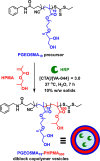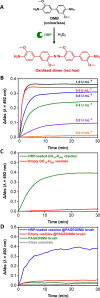Capturing Enzyme-Loaded Diblock Copolymer Vesicles Using an Aldehyde-Functionalized Hydrophilic Polymer Brush
- PMID: 38934738
- PMCID: PMC11238591
- DOI: 10.1021/acs.langmuir.4c01561
Capturing Enzyme-Loaded Diblock Copolymer Vesicles Using an Aldehyde-Functionalized Hydrophilic Polymer Brush
Abstract
Compared to lipids, block copolymer vesicles are potentially robust nanocontainers for enzymes owing to their enhanced chemical stability, particularly in challenging environments. Herein we report that cis-diol-functional diblock copolymer vesicles can be chemically adsorbed onto a hydrophilic aldehyde-functional polymer brush via acetal bond formation under mild conditions (pH 5.5, 20 °C). Quartz crystal microbalance studies indicated an adsorbed amount, Γ, of 158 mg m-2 for vesicle adsorption onto such brushes, whereas negligible adsorption (Γ = 0.1 mg m-2) was observed for a control experiment conducted using a cis-diol-functionalized brush. Scanning electron microscopy and ellipsometry studies indicated a mean surface coverage of around 30% at the brush surface, which suggests reasonably efficient chemical adsorption. Importantly, such vesicles can be conveniently loaded with a model enzyme (horseradish peroxidase, HRP) using an aqueous polymerization-induced self-assembly formulation. Moreover, the immobilized vesicles remained permeable toward small molecules while retaining their enzyme payload. The enzymatic activity of such HRP-loaded vesicles was demonstrated using a well-established colorimetric assay. In principle, this efficient vesicle-on-brush strategy can be applied to a wide range of enzymes and functional proteins for the design of next-generation immobilized nanoreactors for enzyme-mediated catalysis.
Conflict of interest statement
The authors declare no competing financial interest.
Figures









References
-
- Discher B. M.; Bermudez H.; Hammer D. A.; Discher D. E.; Won Y.-Y.; Bates F. S. Cross-linked Polymersome Membranes: Vesicles with Broadly Adjustable Properties. The Journal of Physical Chemistry B 2002, 106, 2848–2854. 10.1021/jp011958z. - DOI
MeSH terms
Substances
LinkOut - more resources
Full Text Sources

